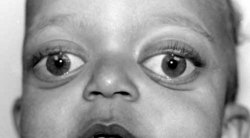Palpebral Fissure, Downslanted
Definition:

Palpebral Fissure, Downslanted
Objective: The palpebral fissure inclination is more than 2 SD below the mean for age
Subjective: The inclination of the palpebral fissure is less than typical for age
Comments: The slant, or inclination, of the palpebral fissure is defined as the angle formed by two lines: an imaginary line that connects the lateral canthus and the medial canthus of each eye, and an imaginary horizontal line formed by the two medial canthi when the patient holds their head with the facial midline vertical, the head in a neutral vertical position (neither flexed nor extended) and the gaze forward [Farkas, [1994]]. Palpebral fissure inclination norms are specified in Farkas [1994] for Caucasians (pg. 283) and for Chinese and African-American populations (limited data, pgs 342, and 349, respectively). Hall et al. [2007] only specifies norms for Caucasians between 6 and 16 years of age. Note that the mean inclination is slightly upslanting at all ages [Farkas, [1994]; Hall et al., [2007]]. Some features (e.g., Ptosis or Epicanthus) may hinder palpebral fissure inclination assessment. Malar and/or zygomatic hypoplasia and Widely spaced eyes may be associated with a downward slant.
Replaces:
COMMENTS (0) | Add Comment









